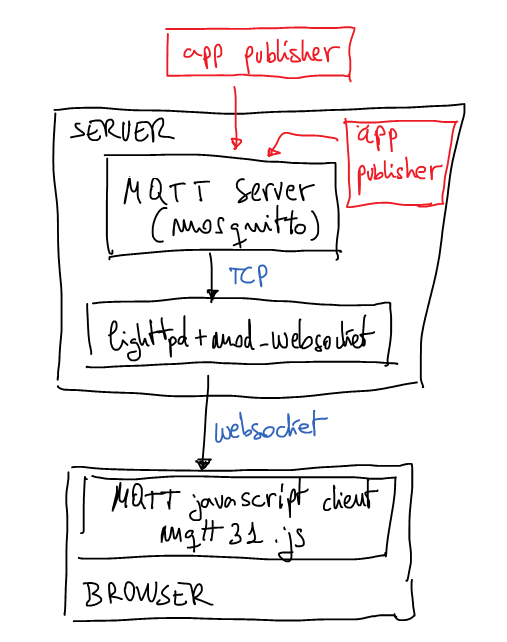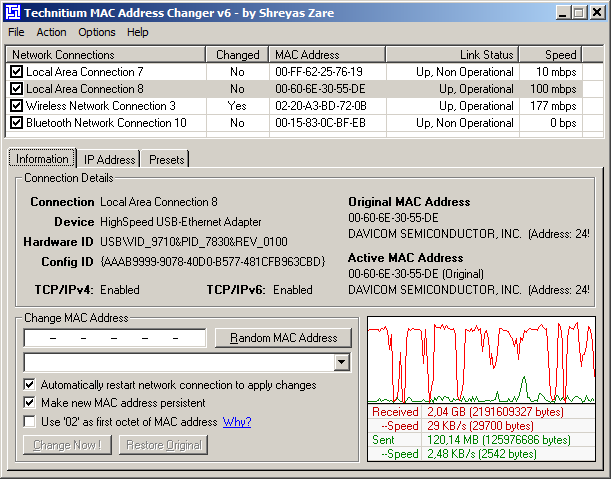Hello World using ‘kombu’ library and python
Reading time: 62 – 103 minutesSome times schemas and snippets don’t need large descriptions. If you think this is not enough in this case tell me and I’m going to add explanations.
Using a python library called kombu as an abstraction to talk with AMQP broker we are going to develop different message routes setting each type of Exchange. As a backend I used RabbitMQ with default configuration.
AMQP schema using an exchange of type direct
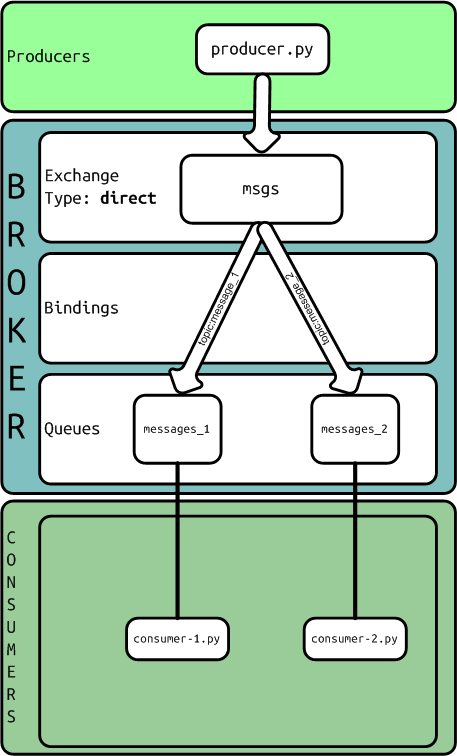
Queue definition:
from kombu import Exchange, Queue task_exchange = Exchange("msgs", type="direct") queue_msg_1 = Queue("messages_1", task_exchange, routing_key = 'message_1') queue_msg_2 = Queue("messages_2", task_exchange, routing_key = 'message_2')
The producer:
from __future__ import with_statement from queues import task_exchange from kombu.common import maybe_declare from kombu.pools import producers if __name__ == "__main__": from kombu import BrokerConnection connection = BrokerConnection("amqp://guest:guest@localhost:5672//") with producers[connection].acquire(block=True) as producer: maybe_declare(task_exchange, producer.channel) payload = {"type": "handshake", "content": "hello #1"} producer.publish(payload, exchange = 'msgs', serializer="pickle", routing_key = 'message_1') payload = {"type": "handshake", "content": "hello #2"} producer.publish(payload, exchange = 'msgs', serializer="pickle", routing_key = 'message_2')
One consumer:
from queues import queue_msg_1 from kombu.mixins import ConsumerMixin class C(ConsumerMixin): def __init__(self, connection): self.connection = connection return def get_consumers(self, Consumer, channel): return [Consumer( queue_msg_1, callbacks = [ self.on_message ])] def on_message(self, body, message): print ("RECEIVED MSG - body: %r" % (body,)) print ("RECEIVED MSG - message: %r" % (message,)) message.ack() return if __name__ == "__main__": from kombu import BrokerConnection from kombu.utils.debug import setup_logging setup_logging(loglevel="DEBUG") with BrokerConnection("amqp://guest:guest@localhost:5672//") as connection: try: C(connection).run() except KeyboardInterrupt: print("bye bye")
AMQP schema using an exchange of type fanout
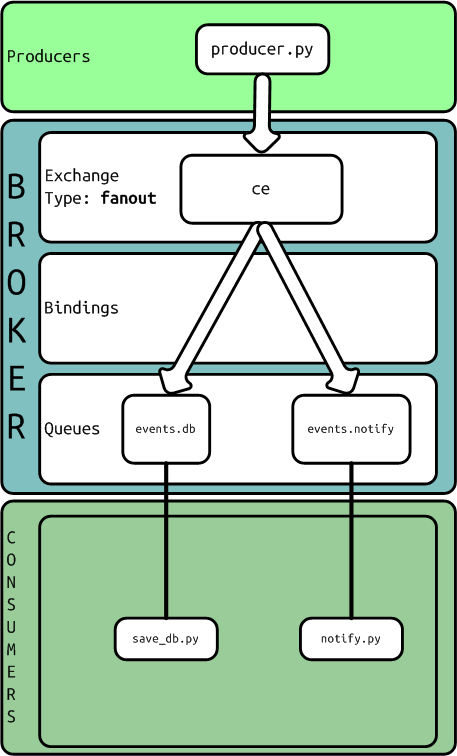
Queue definition:
from kombu import Exchange, Queue task_exchange = Exchange("ce", type="fanout") queue_events_db = Queue("events.db", task_exchange) queue_events_notify = Queue("events.notify", task_exchange)
The producer:
from __future__ import with_statement from queues import task_exchange from kombu.common import maybe_declare from kombu.pools import producers if __name__ == "__main__": from kombu import BrokerConnection connection = BrokerConnection("amqp://guest:guest@localhost:5672//") with producers[connection].acquire(block=True) as producer: maybe_declare(task_exchange, producer.channel) payload = {"operation": "create", "content": "the object"} producer.publish(payload, exchange = 'ce', serializer="pickle", routing_key = 'user.write') payload = {"operation": "update", "content": "updated fields", "id": "id of the object"} producer.publish(payload, exchange = 'ce', serializer="pickle", routing_key = 'user.write')
One consumer:
from queues import queue_events_db from kombu.mixins import ConsumerMixin class C(ConsumerMixin): def __init__(self, connection): self.connection = connection return def get_consumers(self, Consumer, channel): return [Consumer( queue_events_db, callbacks = [self.on_message])] def on_message(self, body, message): print ("save_db: RECEIVED MSG - body: %r" % (body,)) print ("save_db: RECEIVED MSG - message: %r" % (message,)) message.ack() return if __name__ == "__main__": from kombu import BrokerConnection from kombu.utils.debug import setup_logging setup_logging(loglevel="DEBUG") with BrokerConnection("amqp://guest:guest@localhost:5672//") as connection: try: C(connection).run() except KeyboardInterrupt: print("bye bye")
AMQP schema using an exchange of type topic
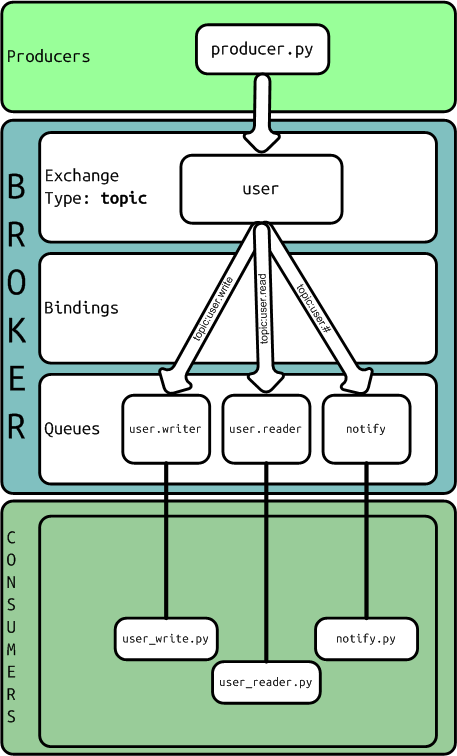
Queue definition:
from kombu import Exchange, Queue task_exchange = Exchange("user", type="topic") queue_user_write = Queue("user.write", task_exchange, routing_key = 'user.write') queue_user_read = Queue("user.read", task_exchange, routing_key = 'user.read') queue_notify = Queue("notify", task_exchange, routing_key = 'user.#')
The producer:
from __future__ import with_statement from queues import task_exchange from kombu.common import maybe_declare from kombu.pools import producers if __name__ == "__main__": from kombu import BrokerConnection connection = BrokerConnection("amqp://guest:guest@localhost:5672//") with producers[connection].acquire(block=True) as producer: maybe_declare(task_exchange, producer.channel) payload = {"operation": "create", "content": "the object"} producer.publish(payload, exchange = 'user', serializer="pickle", routing_key = 'user.write') payload = {"operation": "update", "content": "updated fields", "id": "id of the object"} producer.publish(payload, exchange = 'user', serializer="pickle", routing_key = 'user.write') payload = {"operation": "delete", "id": "id of the object"} producer.publish(payload, exchange = 'user', serializer="pickle", routing_key = 'user.write') payload = {"operation": "read", "id": "id of the object"} producer.publish(payload, exchange = 'user', serializer="pickle", routing_key = 'user.read')
One consumer:
from queues import queue_events_db from kombu.mixins import ConsumerMixin class C(ConsumerMixin): def __init__(self, connection): self.connection = connection return def get_consumers(self, Consumer, channel): return [Consumer( queue_events_db, callbacks = [self.on_message])] def on_message(self, body, message): print ("save_db: RECEIVED MSG - body: %r" % (body,)) print ("save_db: RECEIVED MSG - message: %r" % (message,)) message.ack() return if __name__ == "__main__": from kombu import BrokerConnection from kombu.utils.debug import setup_logging setup_logging(loglevel="DEBUG") with BrokerConnection("amqp://guest:guest@localhost:5672//") as connection: try: C(connection).run() except KeyboardInterrupt: print("bye bye")
Simple queues
Kombu implements SimpleQueue and SimpleBuffer as simple solution for queues with exchange of type ‘direct’, with the same exchange name, routing key and queue name.
Pusher:
from kombu import BrokerConnection connection = BrokerConnection("amqp://guest:guest@localhost:5672//") queue = connection.SimpleQueue("logs") payload = { "severity":"info", "message":"this is just a log", "ts":"2013/09/30T15:10:23" } queue.put(payload, serializer='pickle') queue.close()
Getter:
from kombu import BrokerConnection from Queue import Empty connection = BrokerConnection("amqp://guest:guest@localhost:5672//") queue = connection.SimpleQueue("logs") while 1: try: message = queue.get(block=True, timeout=1) print message.payload message.ack() except Empty: pass except KeyboardInterrupt: break print message queue.close()
The files
Download all example files: kombu-tests.tar.gz
